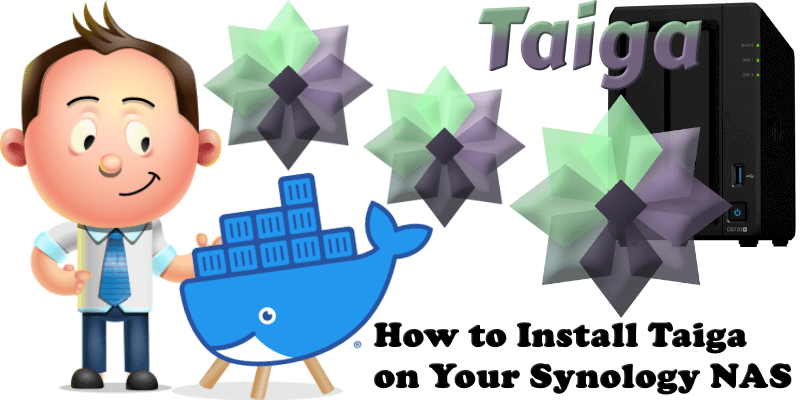
Taiga is an outstanding open source project management kanban software solution that would serve any user or business well. If you want a simple and beautiful tool that makes work truly enjoyable, you should try Taiga. In this step by step guide I will show you how to install Taiga on your Synology NAS using Docker & Portainer.
This guide works perfectly with the latest Taiga v6.8.2 release.
STEP 1
Please Support My work by Making a Donation.
STEP 2
Install Portainer using my step by step guide. If you already have Portainer installed on your Synology NAS, skip this STEP. Attention: Make sure you have installed the latest Portainer version.
STEP 3
Make sure you have a synology.me Wildcard Certificate. Follow my guide to get a Wildcard Certificate. If you already have a synology.me Wildcard certificate, skip this STEP.
STEP 4
Go to Control Panel / Login Portal / Advanced Tab / click Reverse Proxy. Follow the instructions in the image below.
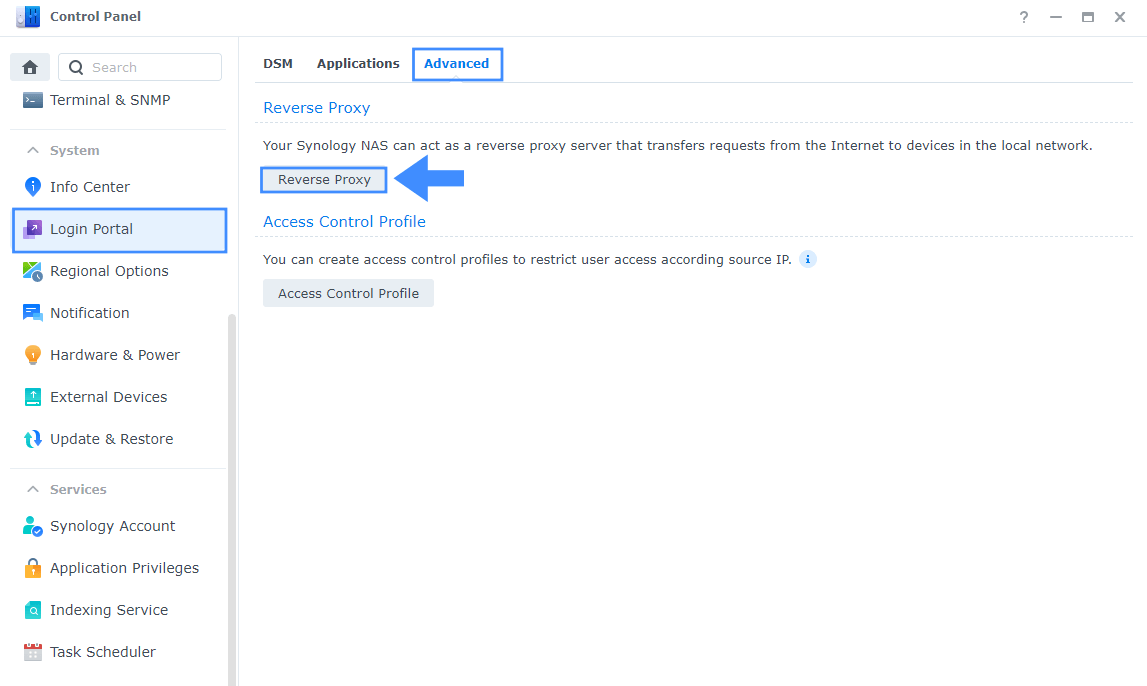
STEP 5
Now click the “Create” button. Follow the instructions in the image below.
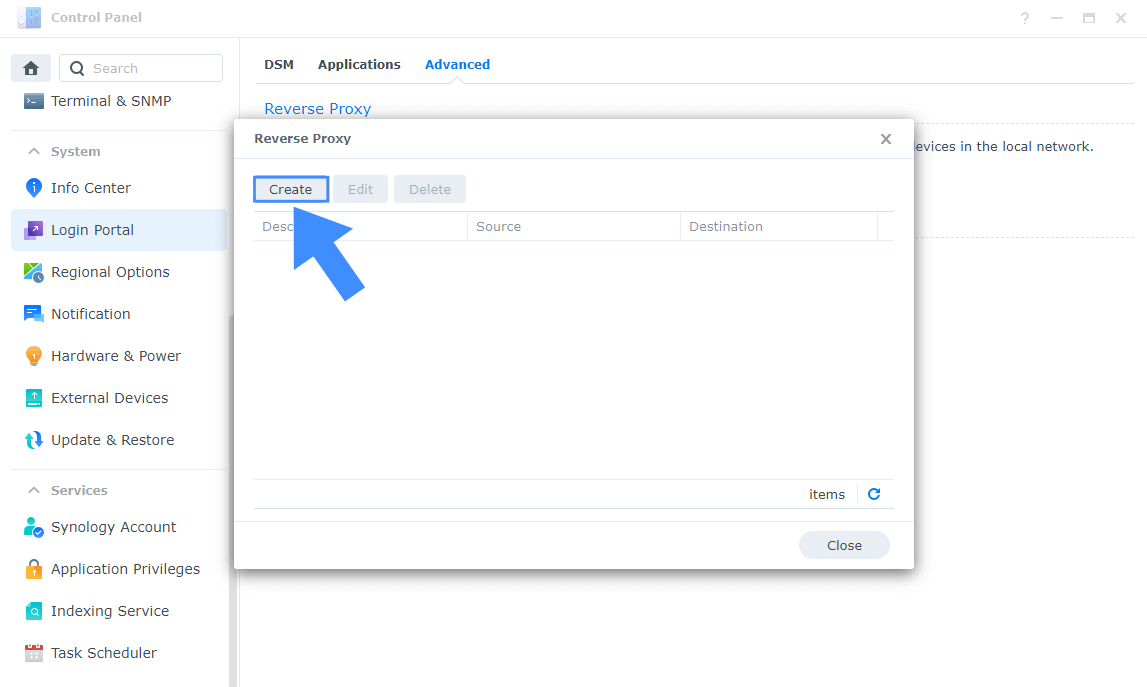
STEP 6
After you click the Create button, the window below will open. Follow the instructions in the image below.
On the General area, set the Reverse Proxy Name description: type in Taiga. After that, add the following instructions:
Source:
Protocol: HTTPS
Hostname: taiga.yourname.synology.me
Port: 443
Check Enable HSTS
Destination:
Protocol: HTTP
Hostname: localhost
Port: 9005
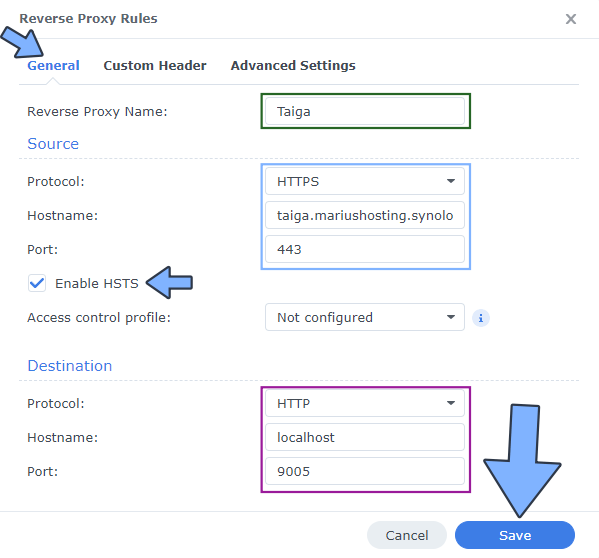
STEP 7
On the Reverse Proxy Rules click the Custom Header tab. Click Create and then, from the drop-down menu, click WebSocket. After you click on WebSocket, two Header Names and two Values will be automatically added. Click Save. Follow the instructions in the image below.

STEP 8
Go to Control Panel / Network / Connectivity tab/ Check Enable HTTP/2 then click Apply. Follow the instructions in the image below.
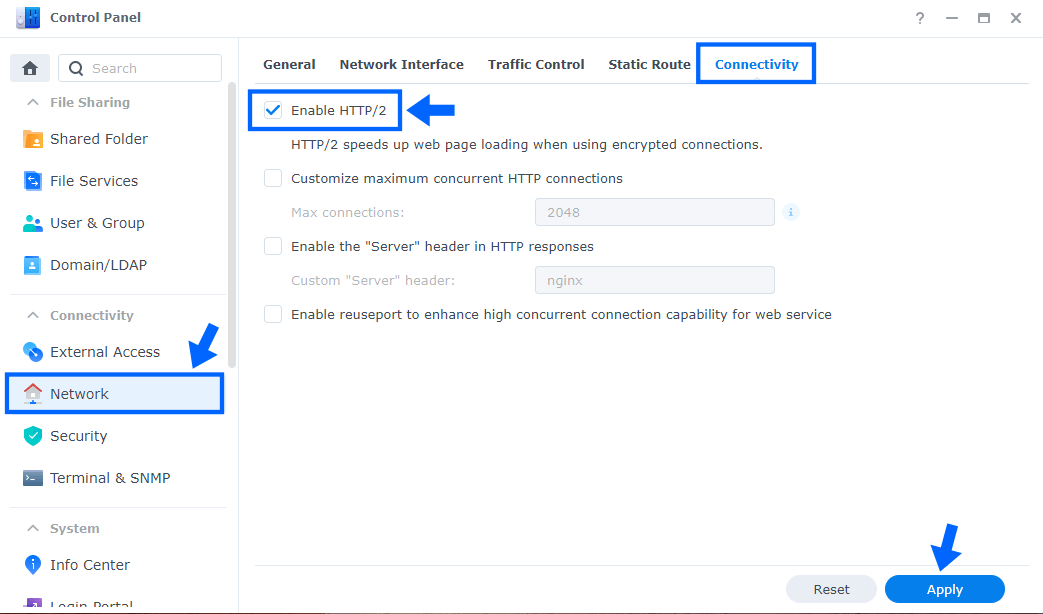
STEP 9
Go to Control Panel / Security / Advanced tab/ Check Enable HTTP Compression then click Apply. Follow the instructions in the image below.
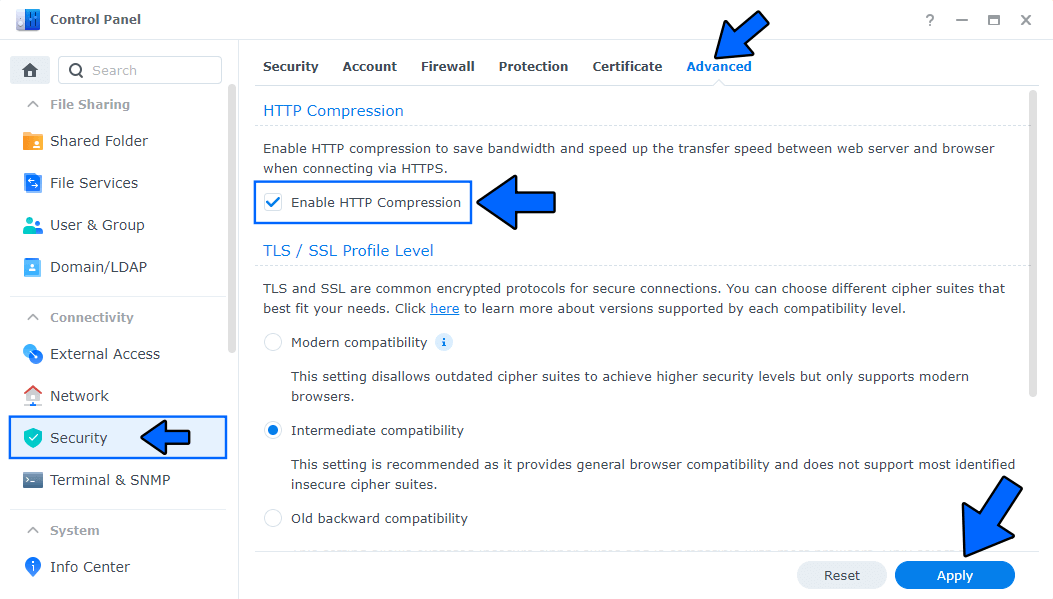
STEP 10
Go to File Station and open the docker folder. Inside the docker folder, create one new folder and name it taiga. Follow the instructions in the image below.
Note: Be careful to enter only lowercase, not uppercase letters.
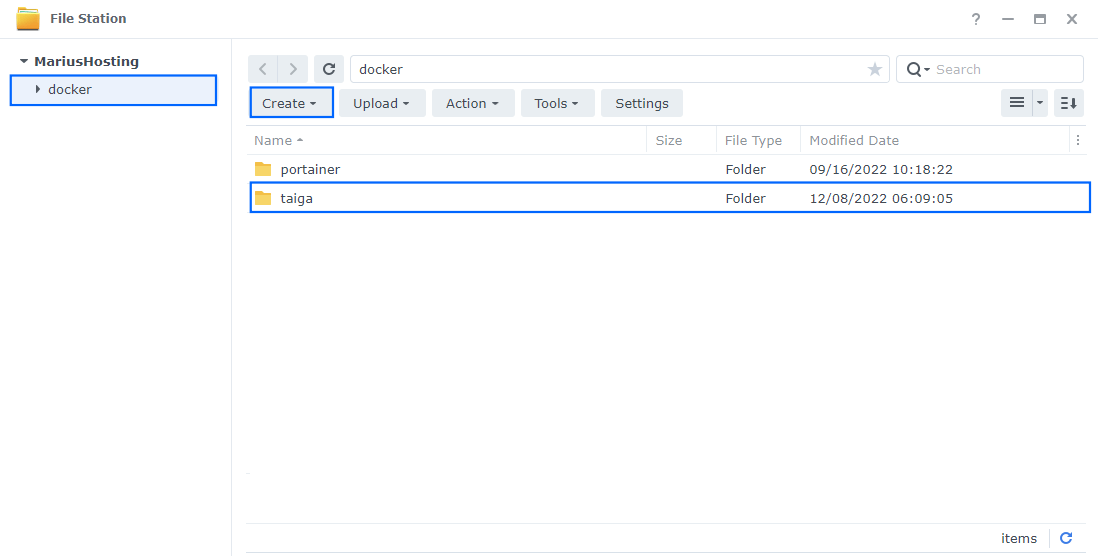
STEP 11
Now create six new folders inside the taiga folder that you created at STEP 10 and name them db, events, gateway, media, rabbitmq, static. Follow the instructions in the image below.
Note: Be careful to enter only lowercase, not uppercase letters.
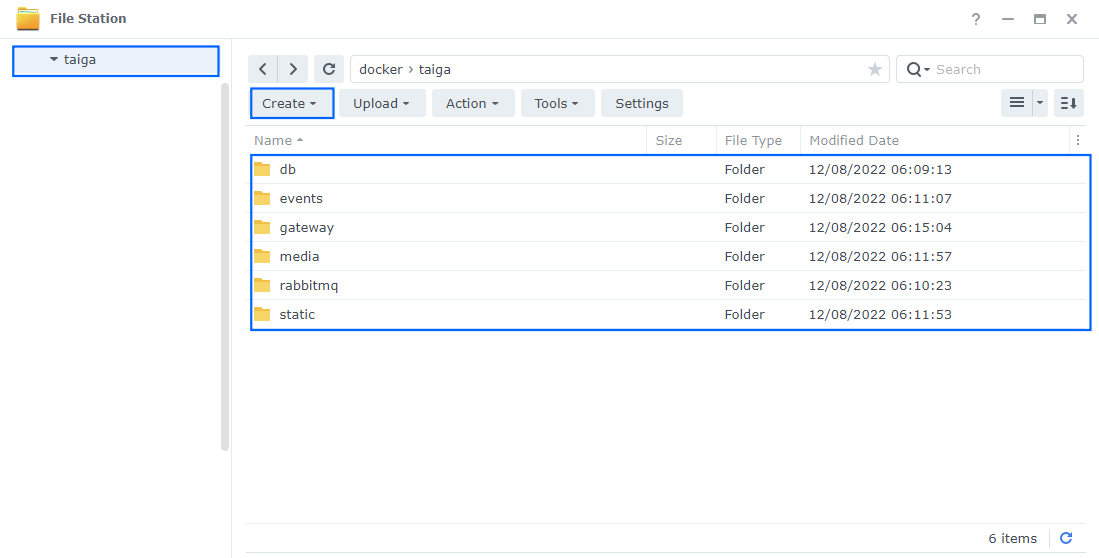
STEP 12
Download (click on the blue link below) then upload the taiga.conf file below in the gateway folder that you have previously created at STEP 11. Follow the instructions in the image below. 🔒Note: Support my work to unlock the password. You can use this password to download any file on mariushosting forever!

STEP 13
Log into Portainer using your username and password. On the left sidebar in Portainer, click on Stacks then + Add stack. Follow the instructions in the image below.

STEP 14
In the Name field type in taiga. Follow the instructions in the image below.
services:
taiga-db:
image: postgres:17
container_name: Taiga-DB
hostname: taiga-db
security_opt:
- no-new-privileges:true
healthcheck:
test: ["CMD", "pg_isready", "-q", "-d", "taiga", "-U", "taigauser"]
interval: 10s
timeout: 5s
retries: 5
volumes:
- /volume1/docker/taiga/db:/var/lib/postgresql/data:rw
environment:
TZ: Europe/Bucharest
POSTGRES_DB: taiga
POSTGRES_USER: taigauser
POSTGRES_PASSWORD: taigapass
restart: on-failure:5
async-rabbitmq:
image: rabbitmq:3.8-management-alpine
container_name: Taiga-ASYNC-RABBITMQ
hostname: taiga-async-rabbitmq
security_opt:
- no-new-privileges:true
user: 1026:100
healthcheck:
test: rabbitmq-diagnostics -q ping
interval: 30s
timeout: 30s
retries: 3
volumes:
- /volume1/docker/taiga/rabbitmq:/var/lib/rabbitmq:rw
environment:
RABBITMQ_ERLANG_COOKIE: secret-erlang-cookie
RABBITMQ_DEFAULT_USER: taigauser
RABBITMQ_DEFAULT_PASS: taigapass
RABBITMQ_DEFAULT_VHOST: taiga
restart: on-failure:5
events-rabbitmq:
image: rabbitmq:3.8-management-alpine
container_name: Taiga-EVENTS-RABBITMQ
hostname: taiga-events-rabbitmq
security_opt:
- no-new-privileges:true
user: 1026:100
healthcheck:
test: rabbitmq-diagnostics -q ping
interval: 30s
timeout: 30s
retries: 3
volumes:
- /volume1/docker/taiga/events:/var/lib/rabbitmq:rw
environment:
RABBITMQ_ERLANG_COOKIE: secret-erlang-cookie
RABBITMQ_DEFAULT_USER: taigauser
RABBITMQ_DEFAULT_PASS: taigapass
RABBITMQ_DEFAULT_VHOST: taiga
restart: on-failure:5
taiga-events:
image: taigaio/taiga-events:latest
container_name: Taiga-EVENTS
hostname: taiga-events
security_opt:
- no-new-privileges:true
healthcheck:
test: wget --no-verbose --tries=1 --spider http://localhost:3023/healthz
environment:
RABBITMQ_USER: taigauser
RABBITMQ_PASS: taigapass
TAIGA_SECRET_KEY: q9TAW5pK5O9DqAWhY18XupmtlZk0ULRmjroiZcfvJkvZduSYzrzc0FtM2yfHEeyB
restart: on-failure:5
depends_on:
events-rabbitmq:
condition: service_healthy
taiga-back:
image: taigaio/taiga-back:latest
container_name: Taiga-BACK
hostname: taiga-back
security_opt:
- no-new-privileges:true
healthcheck:
test: stat /etc/passwd || exit 1
env_file:
- stack.env
environment:
PUBLIC_REGISTER_ENABLED: true
SESSION_COOKIE_SECURE: true
CSRF_COOKIE_SECURE: true
volumes:
- /volume1/docker/taiga/static:/taiga-back/static:rw
- /volume1/docker/taiga/media:/taiga-back/media:rw
restart: on-failure:5
depends_on:
taiga-db:
condition: service_healthy
events-rabbitmq:
condition: service_healthy
async-rabbitmq:
condition: service_healthy
taiga-async:
image: taigaio/taiga-back:latest
entrypoint: ["/taiga-back/docker/async_entrypoint.sh"]
container_name: Taiga-ASYNC
hostname: taiga-async
security_opt:
- no-new-privileges:true
healthcheck:
test: stat /etc/passwd || exit 1
env_file:
- stack.env
volumes:
- /volume1/docker/taiga/static:/taiga-back/static:rw
- /volume1/docker/taiga/media:/taiga-back/media:rw
restart: on-failure:5
depends_on:
taiga-db:
condition: service_healthy
taiga-back:
condition: service_healthy
async-rabbitmq:
condition: service_healthy
taiga-protected:
image: taigaio/taiga-protected:latest
container_name: Taiga-PROTECTED
hostname: taiga-protected
security_opt:
- no-new-privileges:true
healthcheck:
test: stat /etc/passwd || exit 1
environment:
MAX_AGE: 360
SECRET_KEY: q9TAW5pK5O9DqAWhY18XupmtlZk0ULRmjroiZcfvJkvZduSYzrzc0FtM2yfHEeyB
restart: on-failure:5
taiga-front:
image: taigaio/taiga-front:latest
container_name: Taiga-FRONT
hostname: taiga-front
security_opt:
- no-new-privileges:true
healthcheck:
test: wget --no-verbose --tries=1 --spider http://localhost:80/
environment:
TAIGA_URL: https://taiga.yourname.synology.me
TAIGA_WEBSOCKETS_URL: wss://taiga.yourname.synology.me
TAIGA_SUBPATH: ""
PUBLIC_REGISTER_ENABLED: "true"
restart: on-failure:5
taiga-gateway:
image: nginx:1.19-alpine
container_name: Taiga-GATEWAY
hostname: taiga-gateway
security_opt:
- no-new-privileges:true
healthcheck:
test: wget --no-verbose --tries=1 --spider http://localhost:80/
ports:
- 9005:80
volumes:
- /volume1/docker/taiga/gateway/taiga.conf:/etc/nginx/conf.d/default.conf:ro
- /volume1/docker/taiga/static:/taiga/static:rw
- /volume1/docker/taiga/media:/taiga/media:rw
restart: on-failure:5
depends_on:
taiga-front:
condition: service_healthy
taiga-back:
condition: service_healthy
taiga-events:
condition: service_healthy
Note: Before you paste the code above in the Web editor area below, change the value for TZ. (Select your current Time Zone from this list.)
Note: Before you paste the code above in the Web editor area below, change the value numbers for user with your own UID and GID values. (Follow my step by step guide on how to do this.) 1026 is my personal UID value and 100 is my personal GID value. You have to type in your own values.
Note: Before you paste the code above in the Web editor area below, change the value for TAIGA_SECRET_KEY. (Generate your own 64 length TAIGA_SECRET_KEY.)
Note: Before you paste the code above in the Web editor area below, change the value for TAIGA_KEY. Add the same identical Key that you have previously added for TAIGA_SECRET_KEY.
Note: Before you paste the code above in the Web editor area below, change the value for TAIGA_URL and type in your own synology.me DDNS that you have previously created at STEP 6 with https:// at the beginning.
Note: Before you paste the code above in the Web editor area below, change the value for TAIGA_WEBSOCKETS_URL and type in your own synology.me DDNS that you have previously created at STEP 6 without https:// at the beginning.
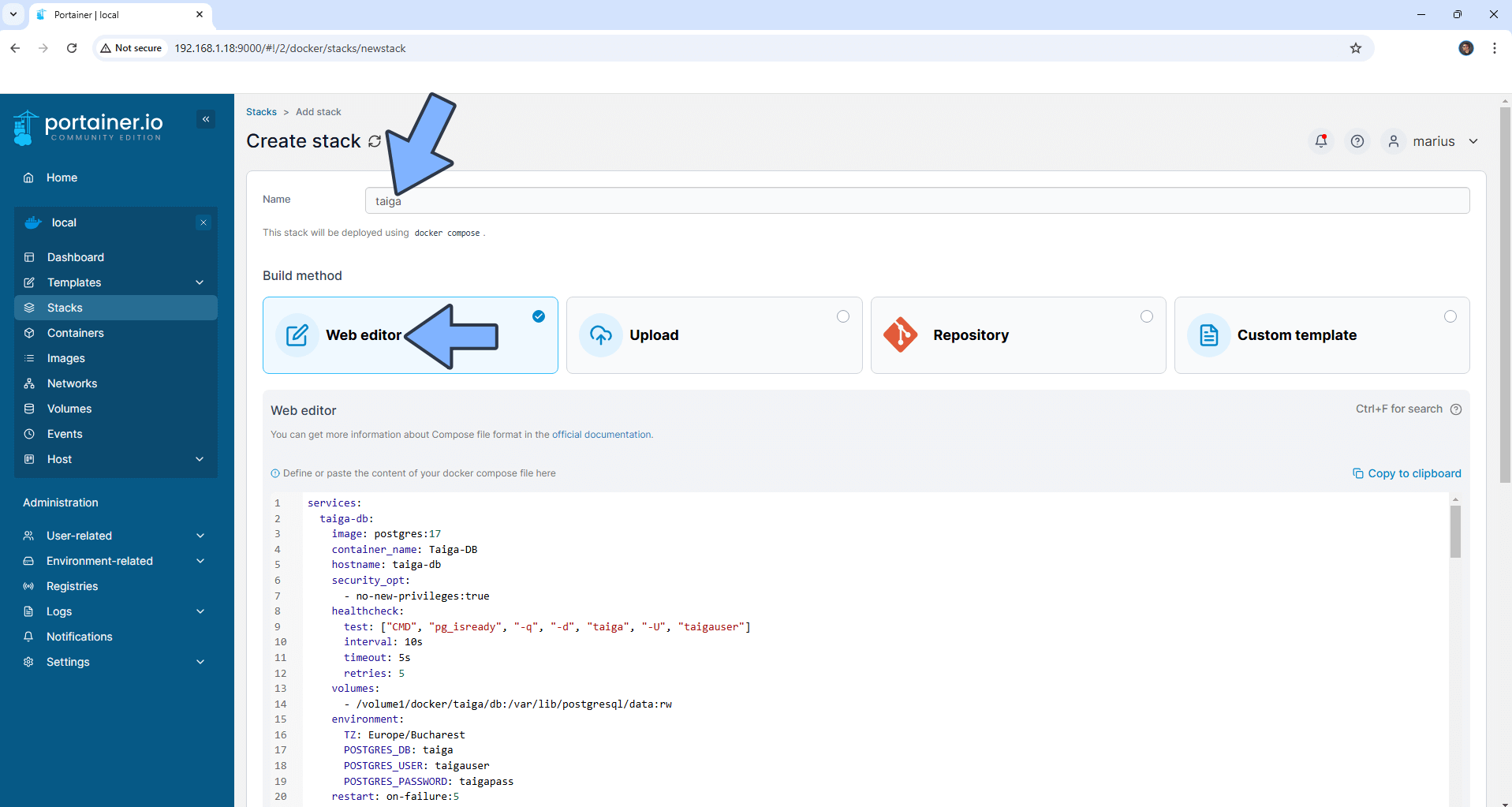
STEP 15
Click the Upload button after Web editor. Download the stack.env file by clicking the blue link below and then upload it from your computer in the “Load variables from .env files“. Follow the instructions in the image below. 🔒Note: Support my work to unlock the password. You can use this password to download any file on mariushosting forever!
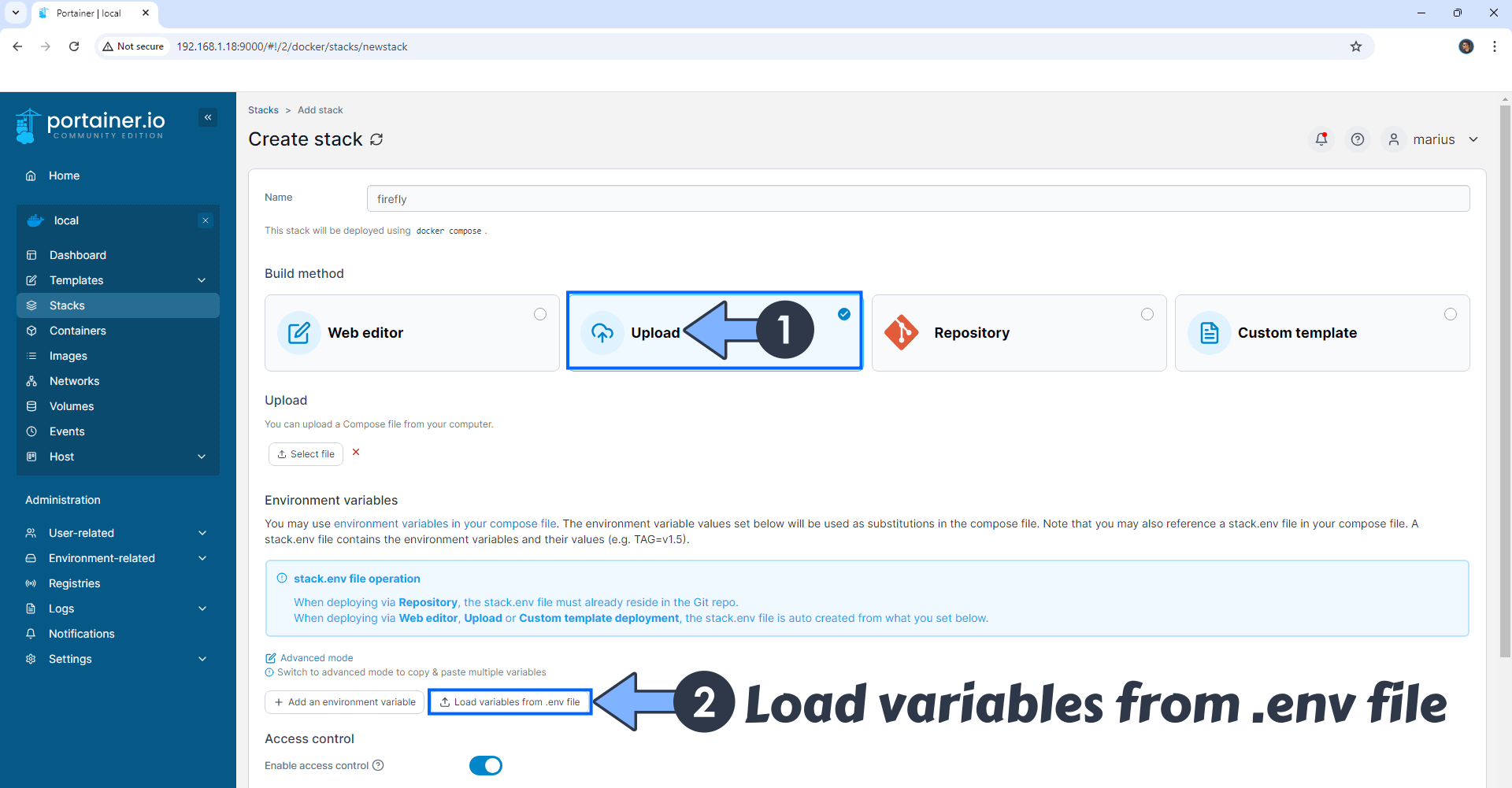
STEP 16
Note: In the TAIGA_SITES_DOMAIN value area, type in your own synology.me DDNS that you have previously created at STEP 6 without https:// at the beginning. Follow the instructions in the image below.
Note: In the TAIGA_SECRET_KEY value area, type in your own TAIGA_SECRET_KEY that you have previously added at STEP 14.
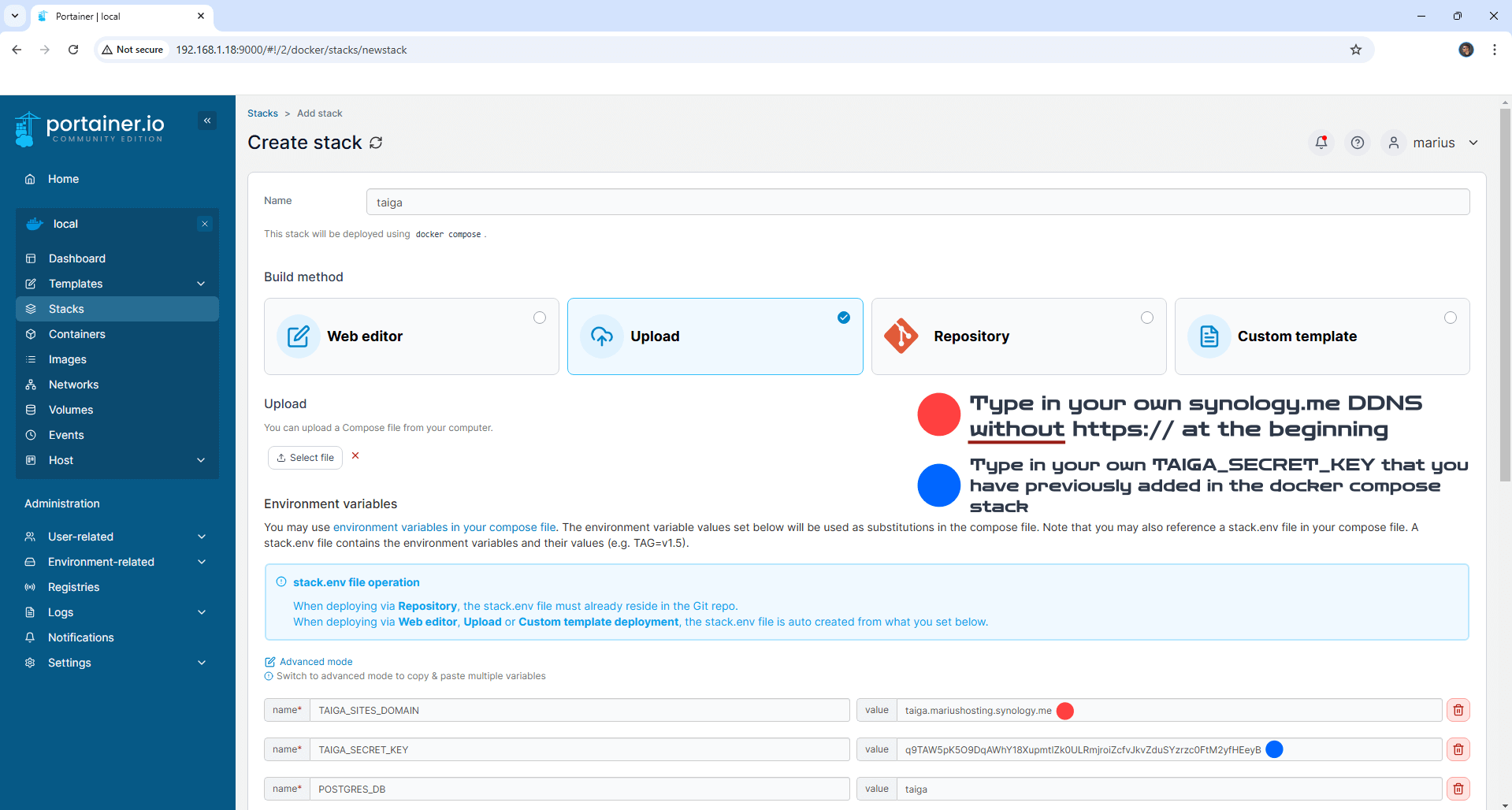
STEP 17
After you make the change and add your own NAS IP value at STEP 16, click the Web editor button. Follow the instructions in the image below.
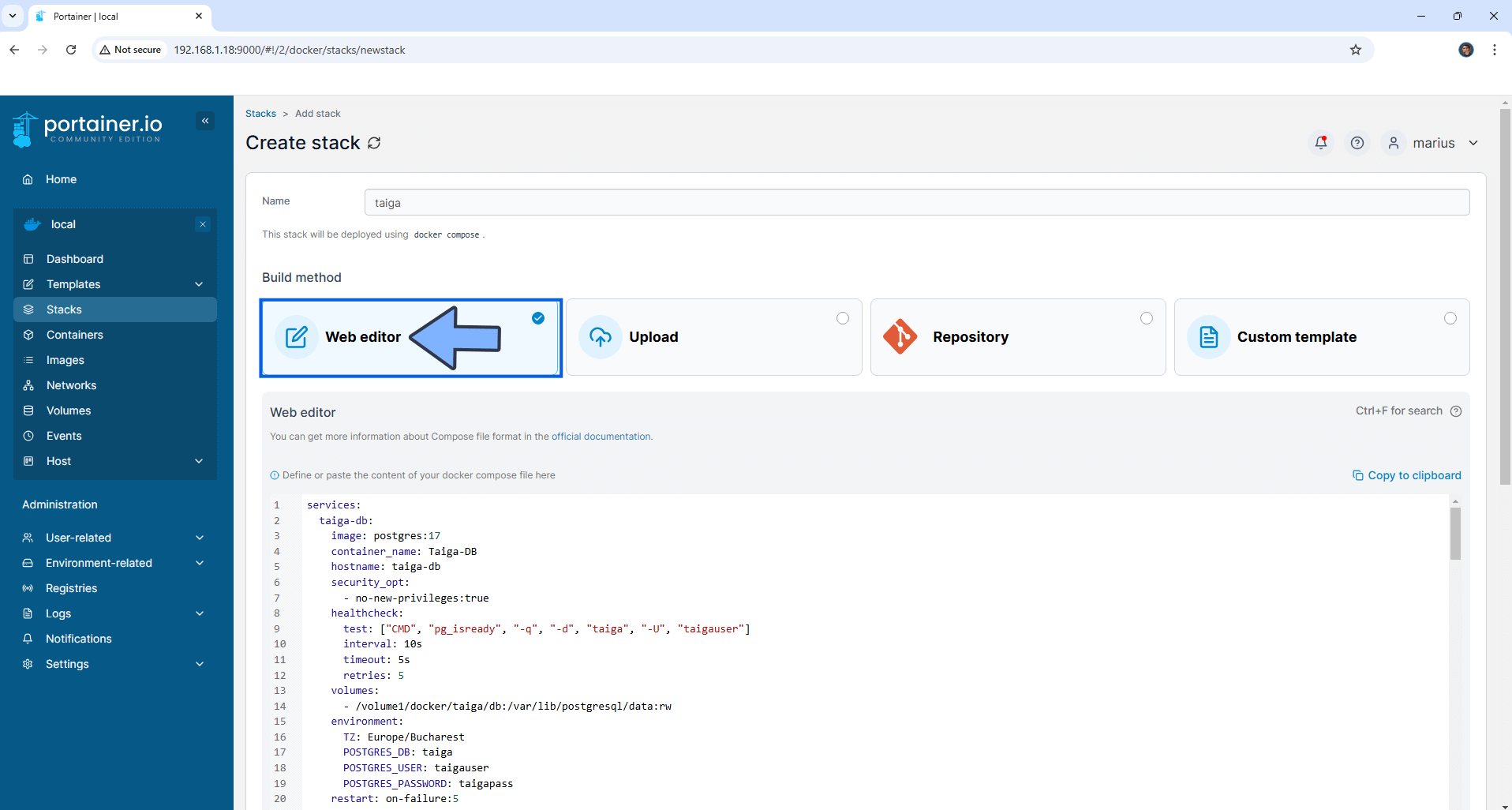
STEP 18
Scroll down on the page until you see a button named Deploy the stack. Click on it. Follow the instructions in the image below. The installation process can take up to a few minutes. It will depend on your Internet speed connection.
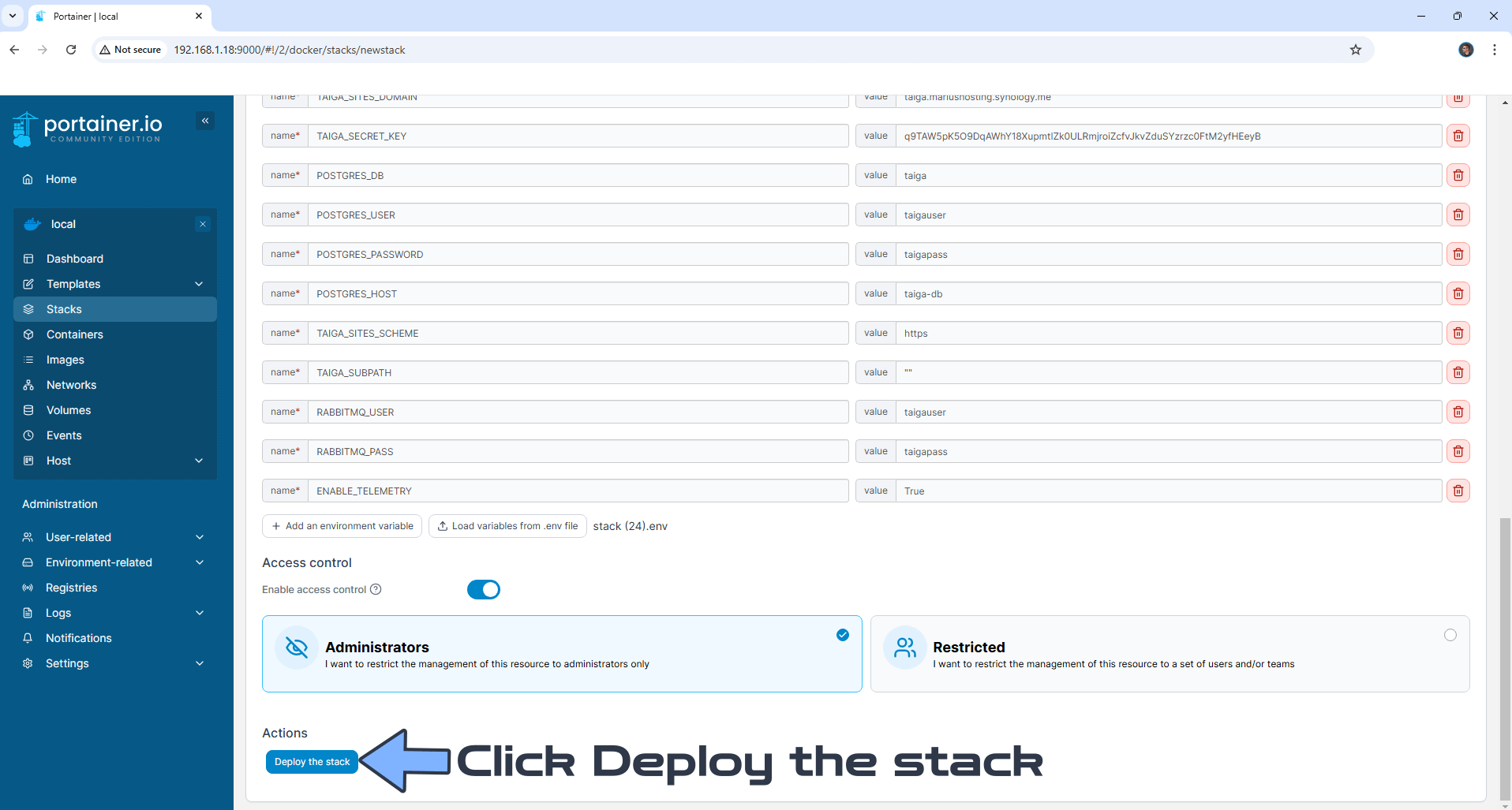
STEP 19
If everything goes right, you will see the following message at the top right of your screen: “Success Stack successfully deployed“.
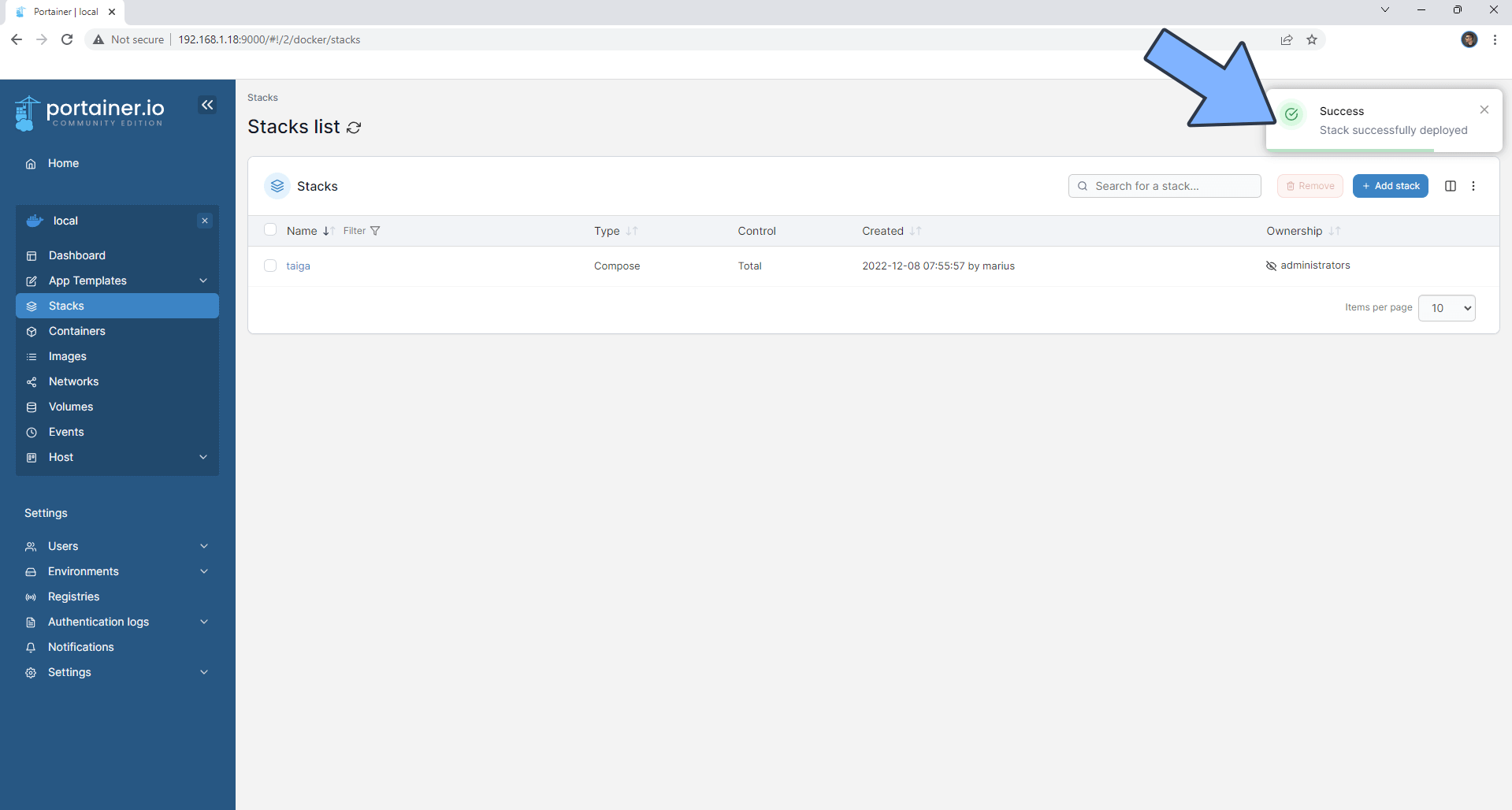
STEP 20
Go back to STEP 1 or you will deal with karma 🙂.
STEP 21
On the left sidebar in Portainer, click Containers. Identify your Taiga-BACK instance, then click on the little terminal icon. Follow the instructions in the image below.
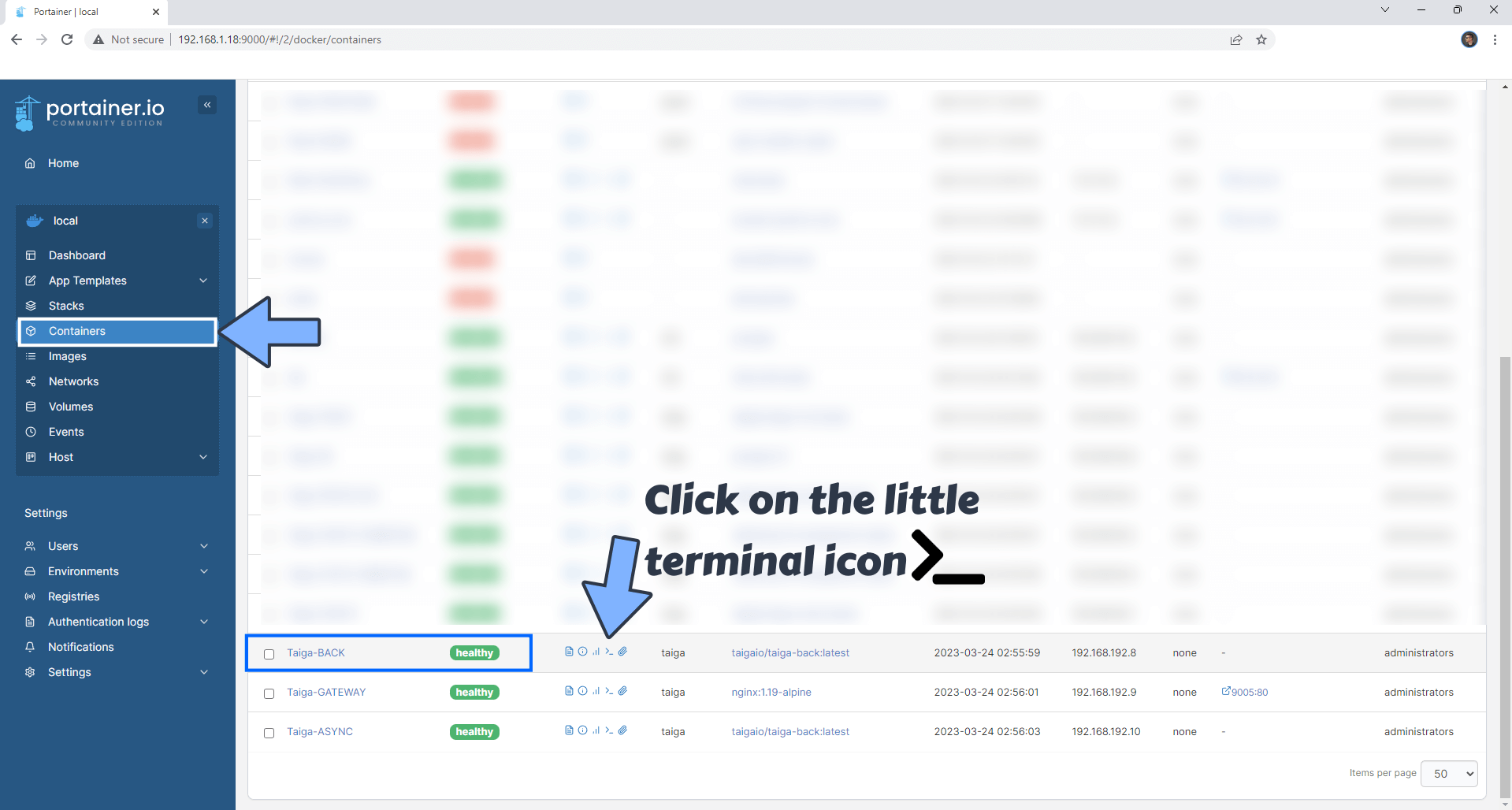
STEP 22
After you click on the little terminal icon at STEP 21, a new page will open. Click Connect. Follow the instructions in the image below.
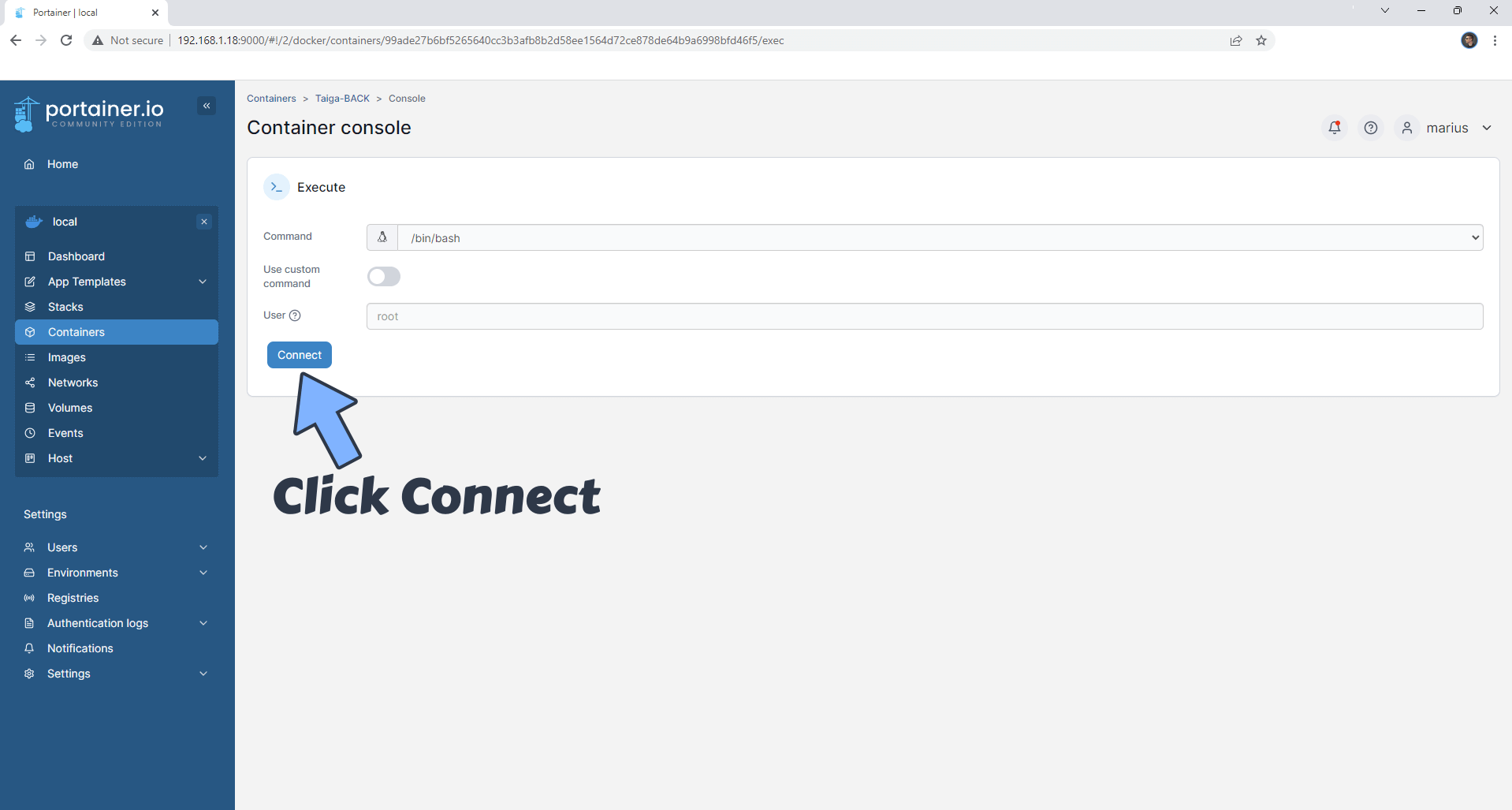
STEP 23
After you click Connect at STEP 22, a Console will open. Copy Paste the code below and follow the instructions in the image.
python manage.py createsuperuser
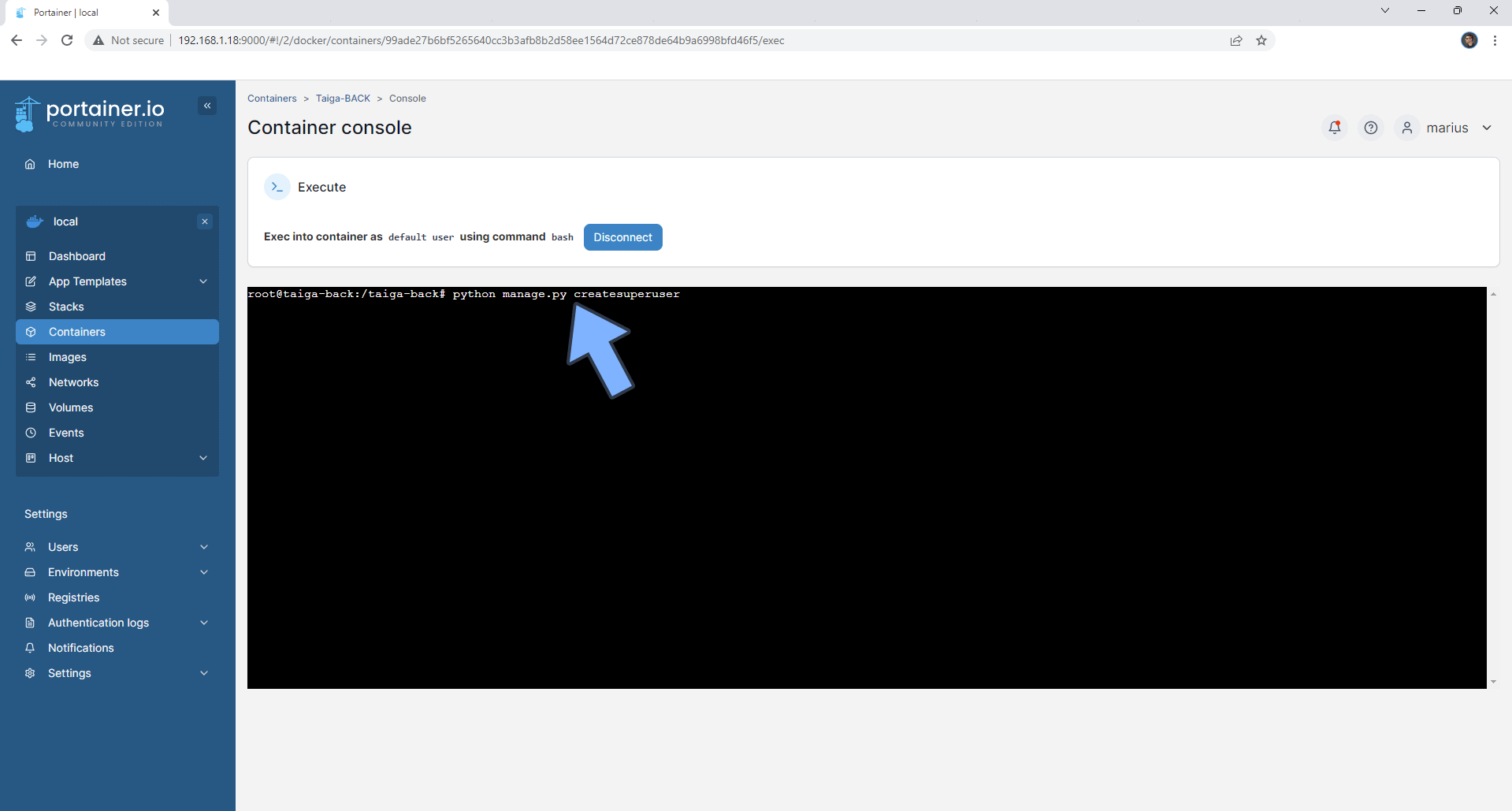
STEP 24
Once the code is inserted, confirm by pressing Enter on your keyboard. Type in your own Username then confirm by pressing Enter on your keyboard. Follow the instructions in the image below.
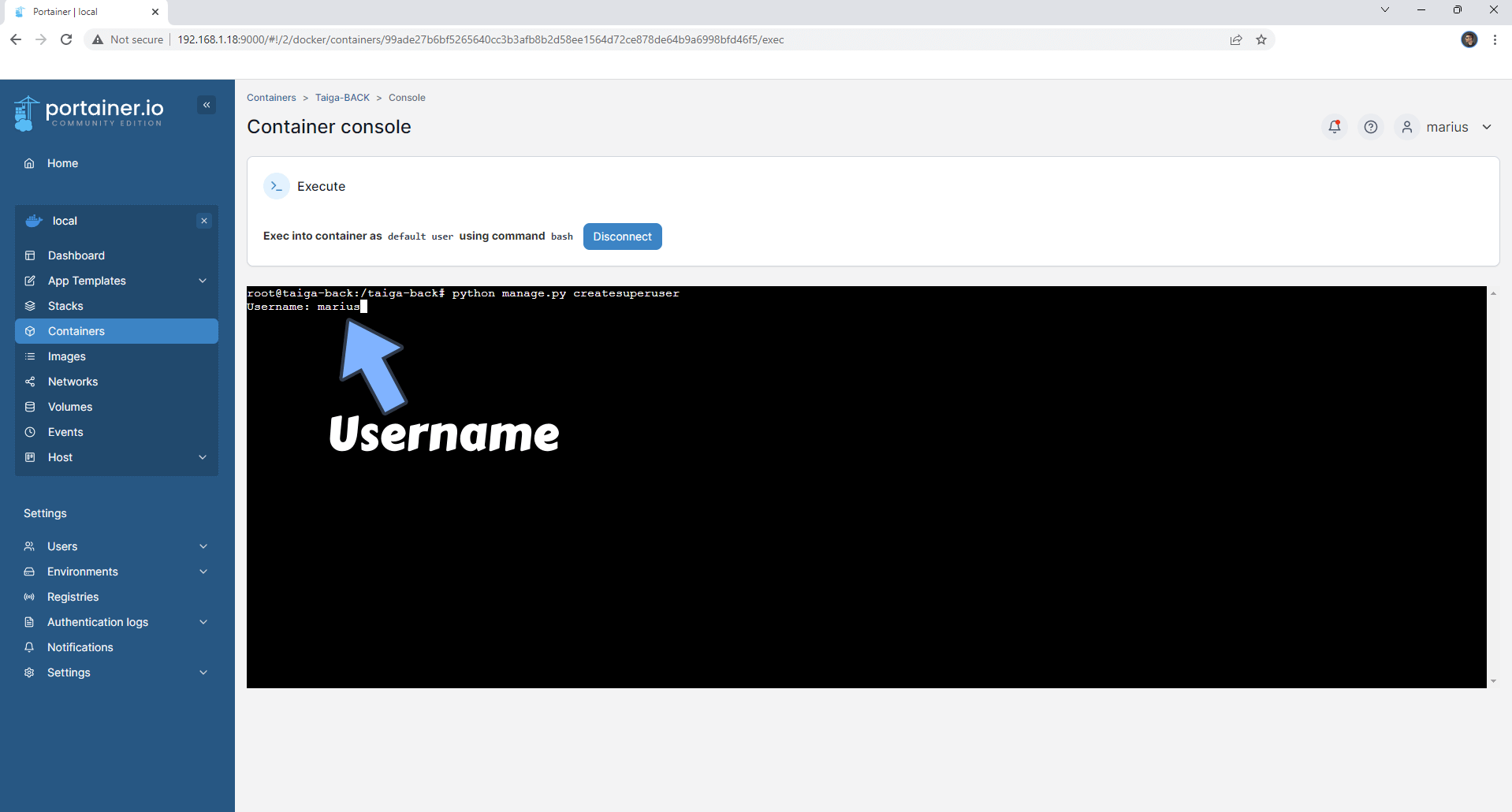
STEP 25
Type in your own Email then confirm by pressing Enter on your keyboard. Follow the instructions in the image below.
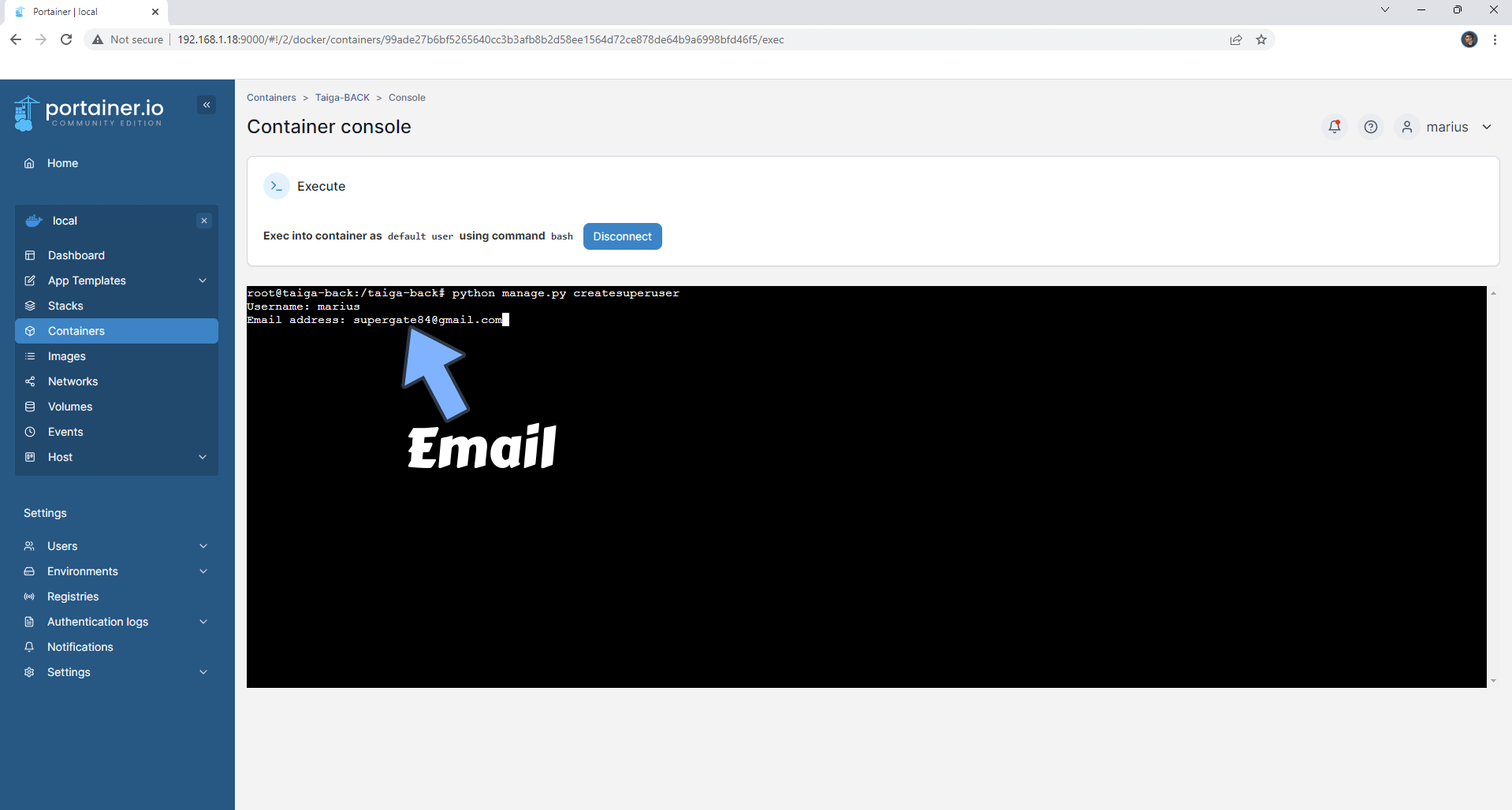
STEP 26
Type in your own Password then confirm by pressing Enter on your keyboard. Confirm the Password then confirm by pressing Enter on your keyboard. Follow the instructions in the image below.
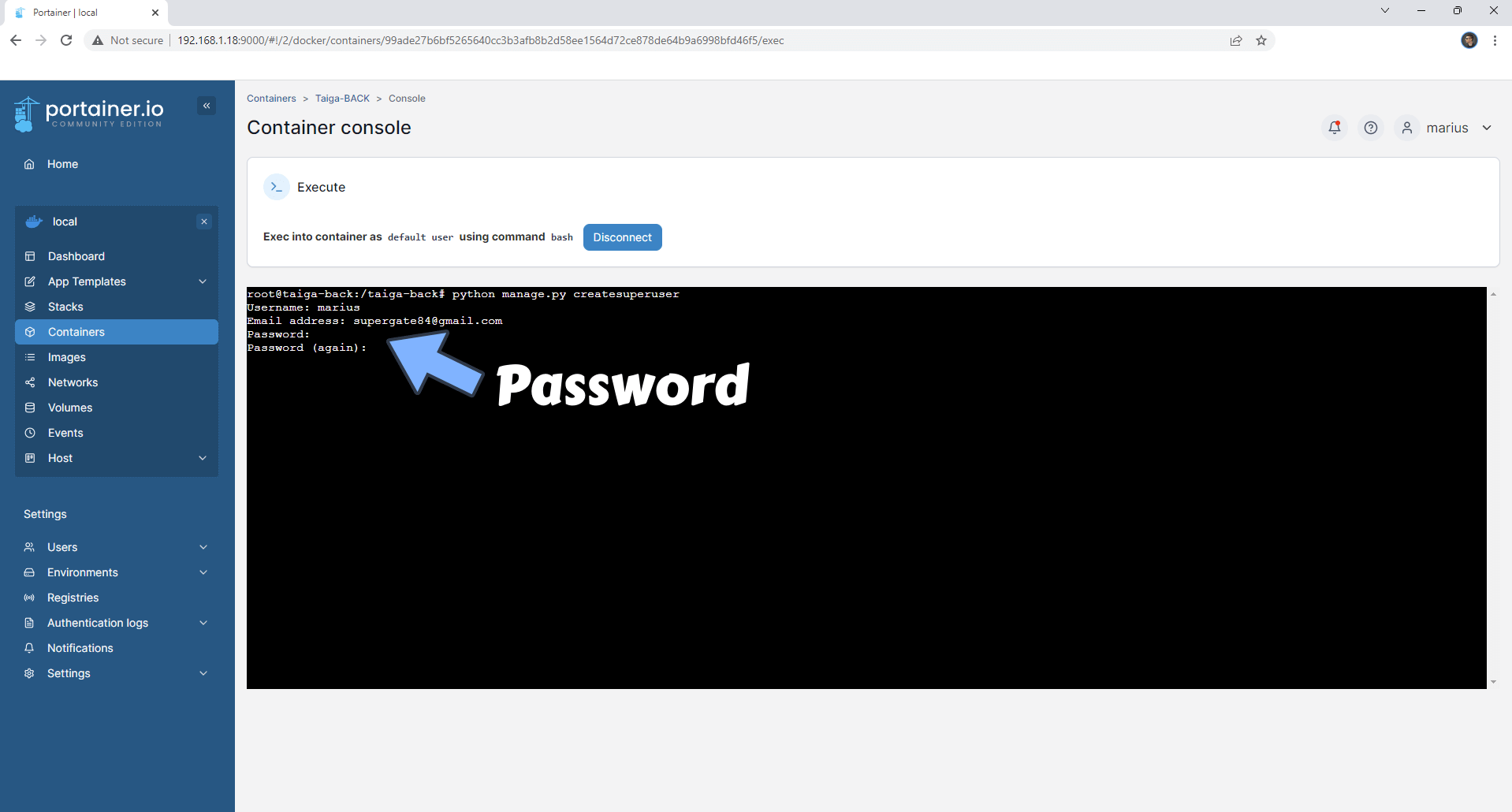
STEP 27
Done! Your superuser admin is successfully created.
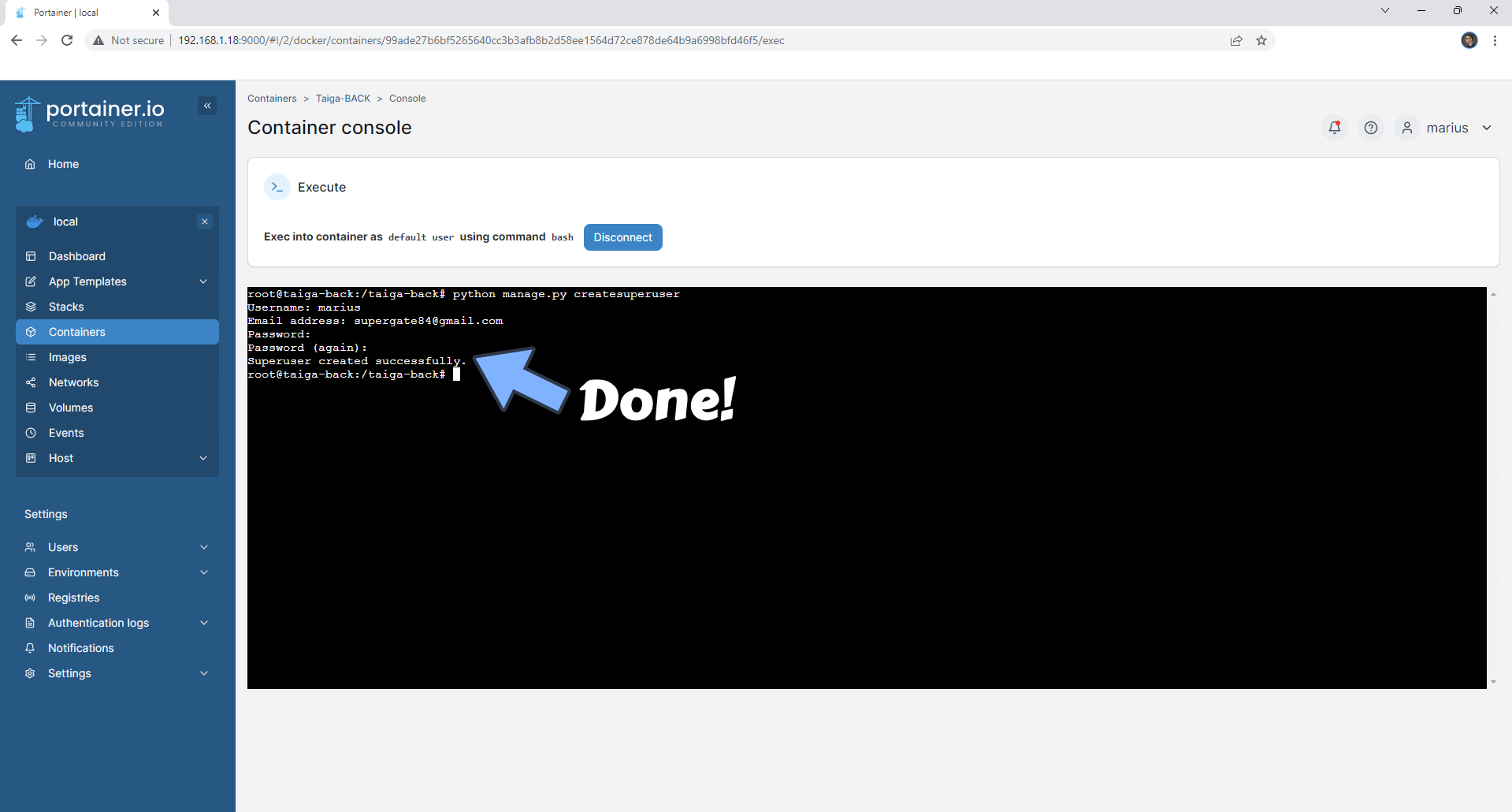
STEP 28
Now open your browser and type in your HTTPS/SSL certificate like this https://taiga.yourname.synology.me In my case it’s https://taiga.mariushosting.synology.me If everything goes right, you will see the Taiga main page. Click Login. Follow the instructions in the image below.
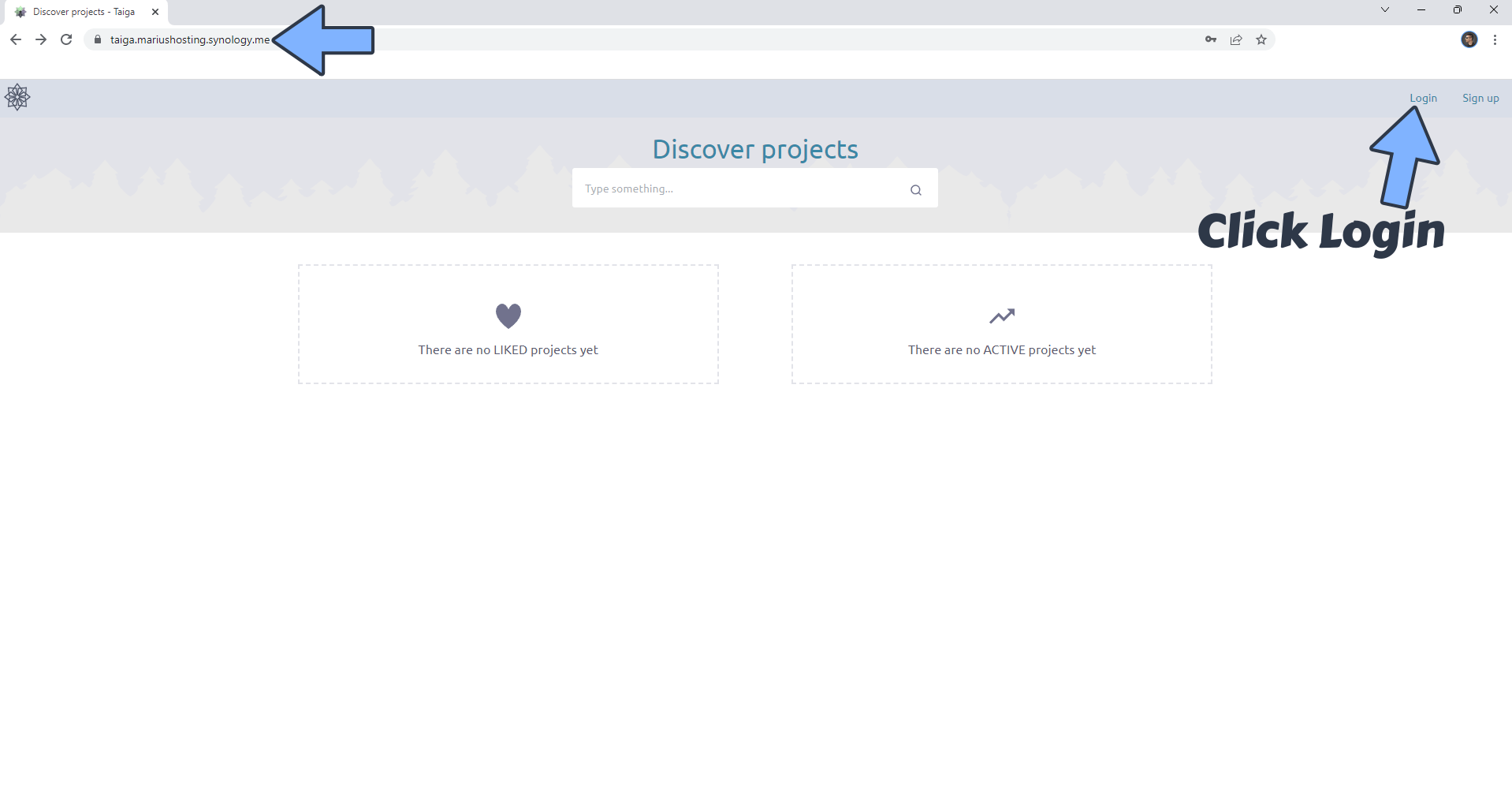
STEP 29
Type in your own Credentials (Email and Password) that you have previously created at STEP 24 and STEP 26, respectively. click LOGIN. Follow the instructions in the image below.
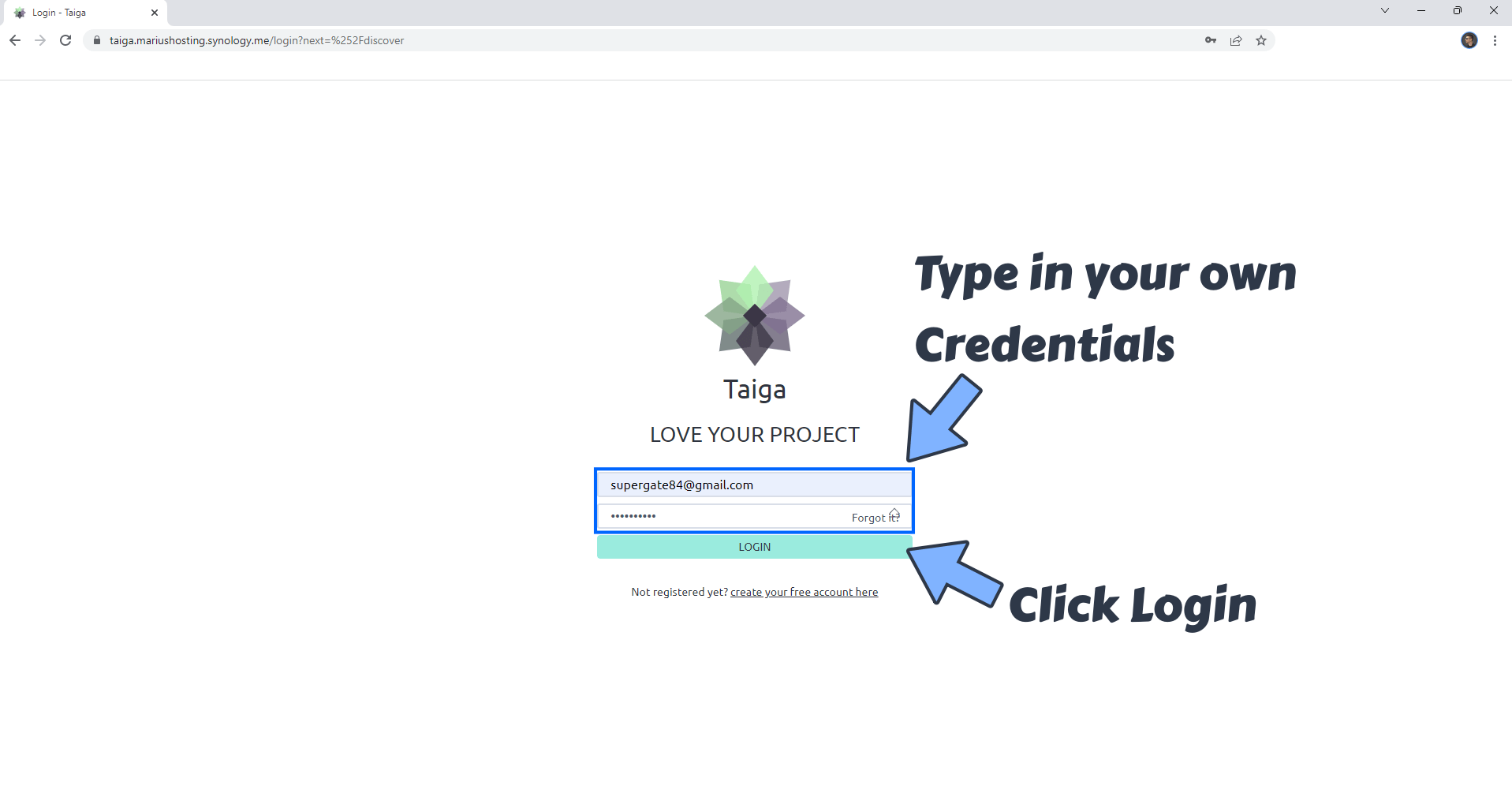
STEP 30
Choose your Project!
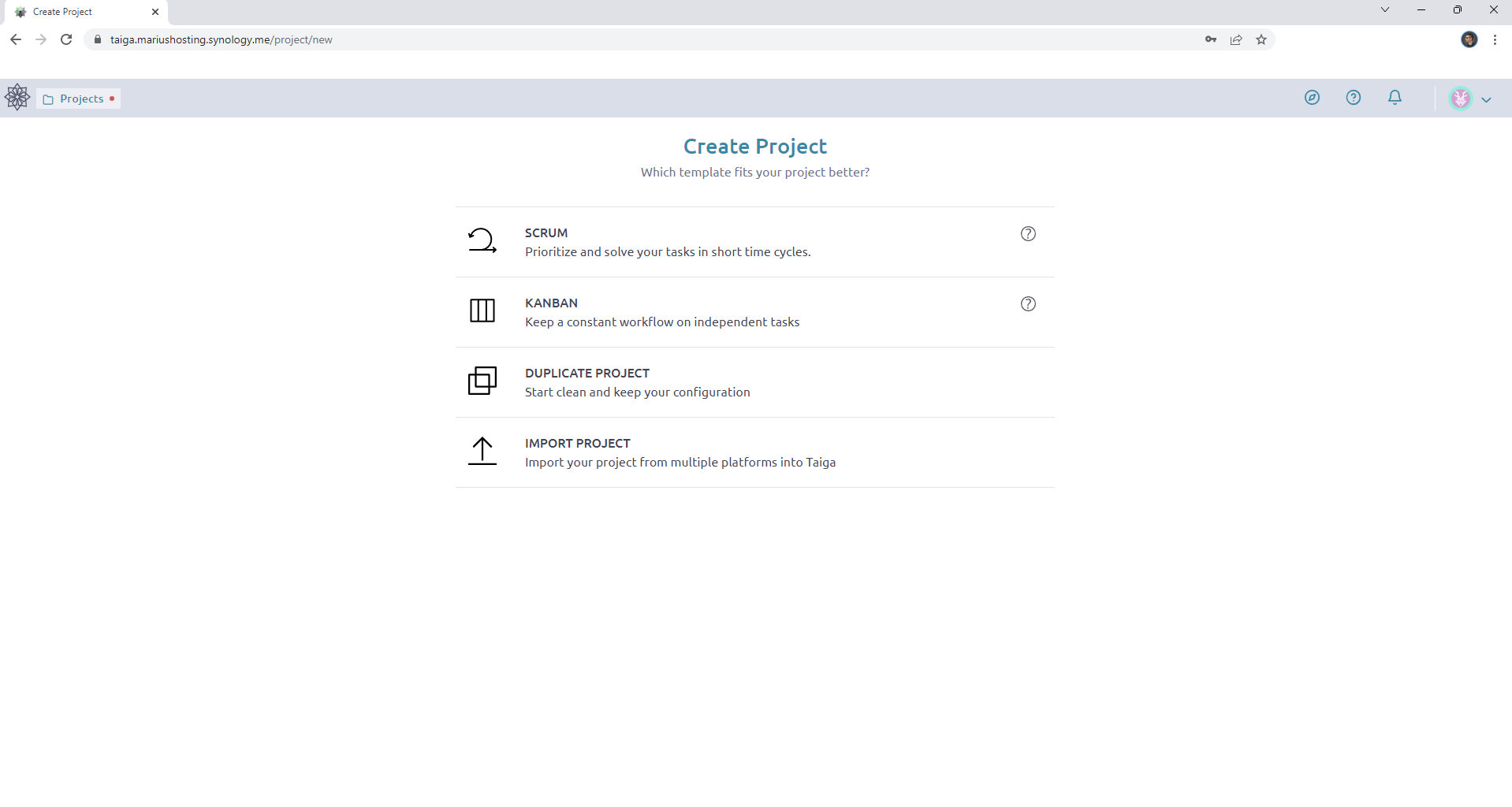
STEP 31
If you want to disable user registration at STEP 14, change the environment variable from PUBLIC_REGISTER_ENABLED: true to PUBLIC_REGISTER_ENABLED: false click Update the stack to apply the changes.
Enjoy Taiga!
If you encounter issues by using this container, make sure to check out the Common Docker issues article.
Note: Find out how to update the Taiga container with the latest image.
Note: How to Back Up Docker Containers on your Synology NAS.
Note: Can I run Docker on my Synology NAS? See the supported models.
Note: How to Free Disk Space on Your NAS if You Run Docker.
Note: How to Schedule Start & Stop For Docker Containers.
Note: How to Activate Email Notifications.
Note: How to Add Access Control Profile on Your NAS.
Note: How to Change Docker Containers Restart Policy.
Note: How to Use Docker Containers With VPN.
Note: Convert Docker Run Into Docker Compose.
Note: How to Clean Docker.
Note: How to Clean Docker Automatically.
Note: Best Practices When Using Docker and DDNS.
Note: Some Docker Containers Need WebSocket.
Note: Find out the Best NAS Models For Docker.
Note: Activate Gmail SMTP For Docker Containers.
This post was updated on Tuesday / March 4th, 2025 at 2:55 PM
